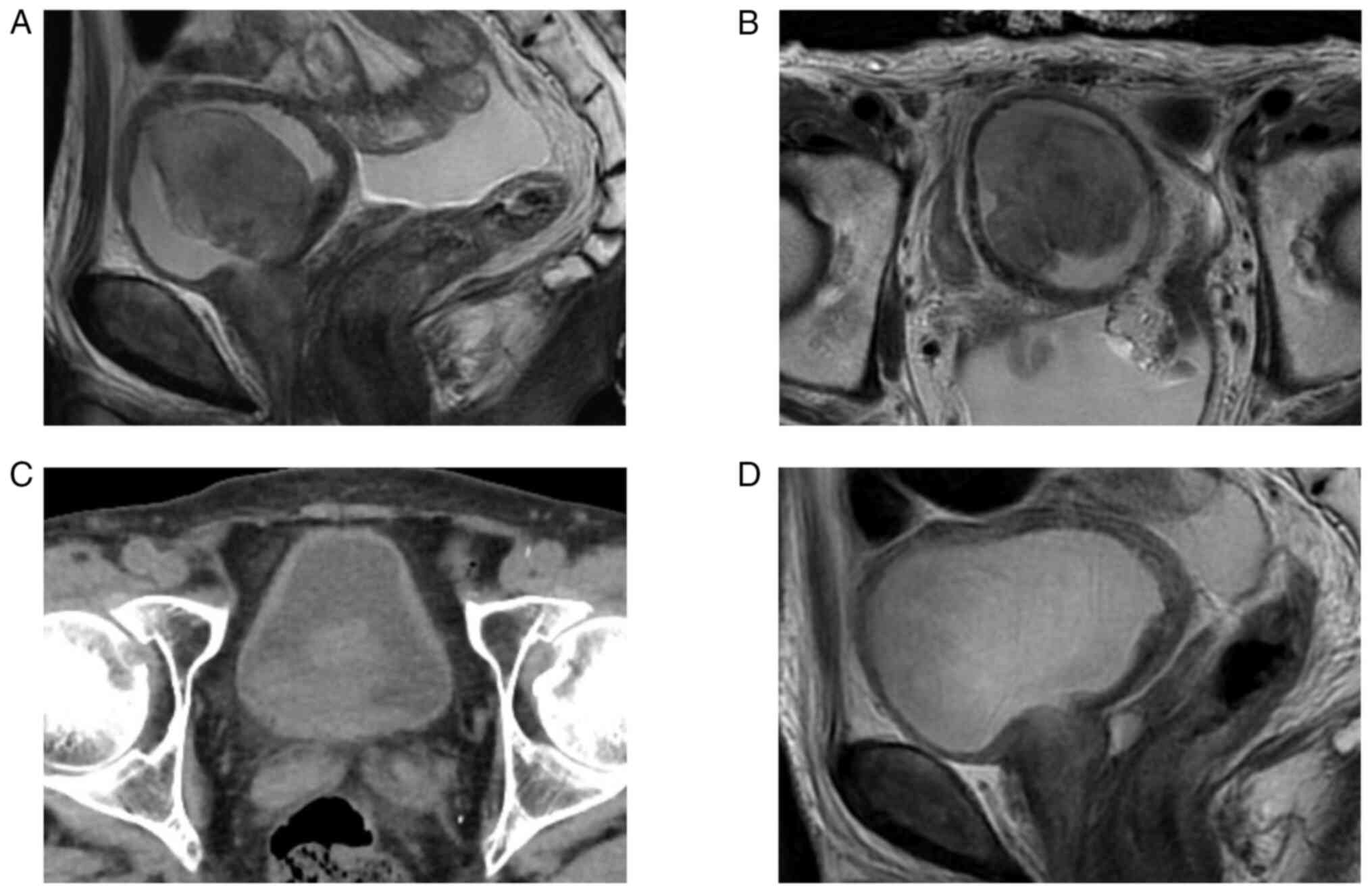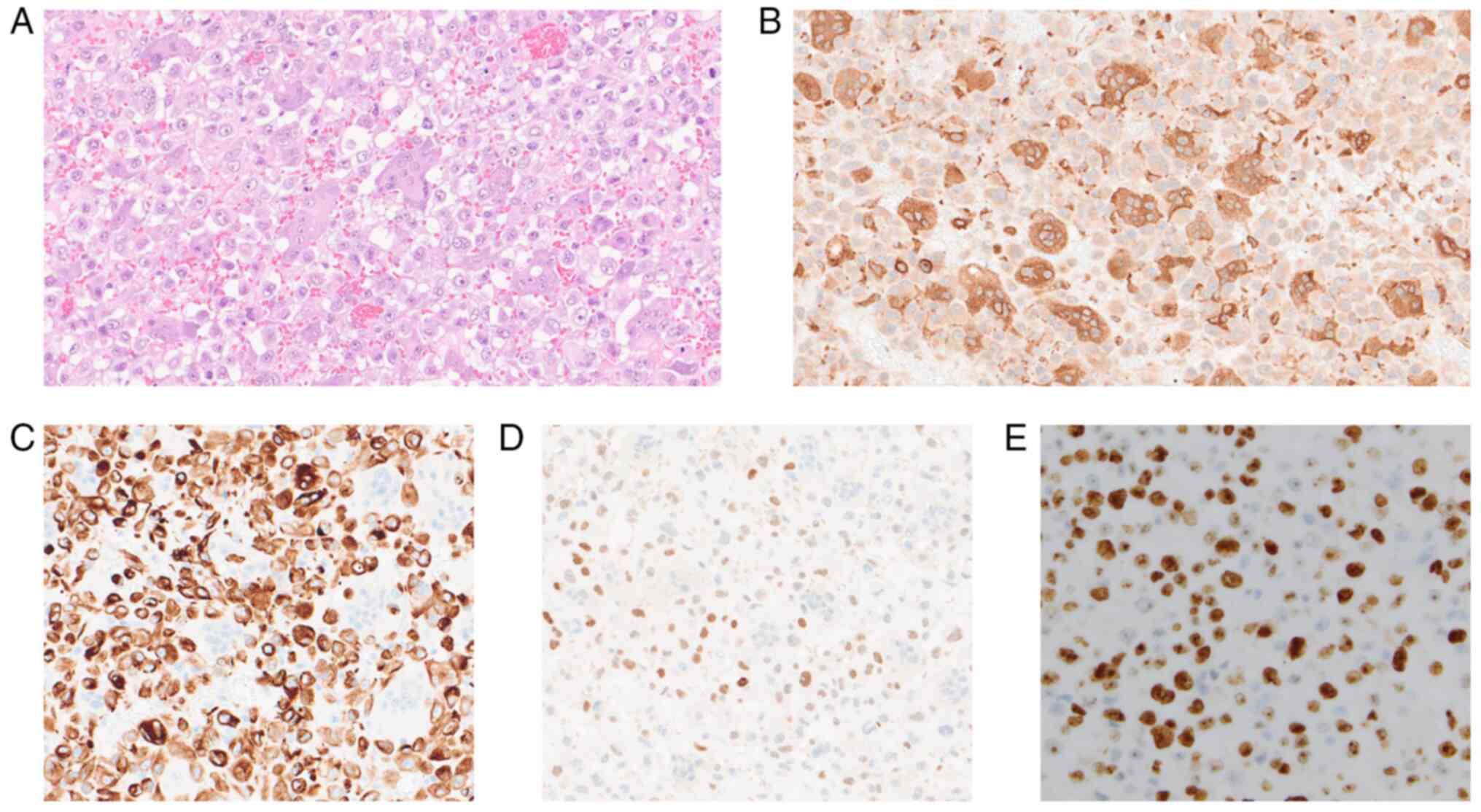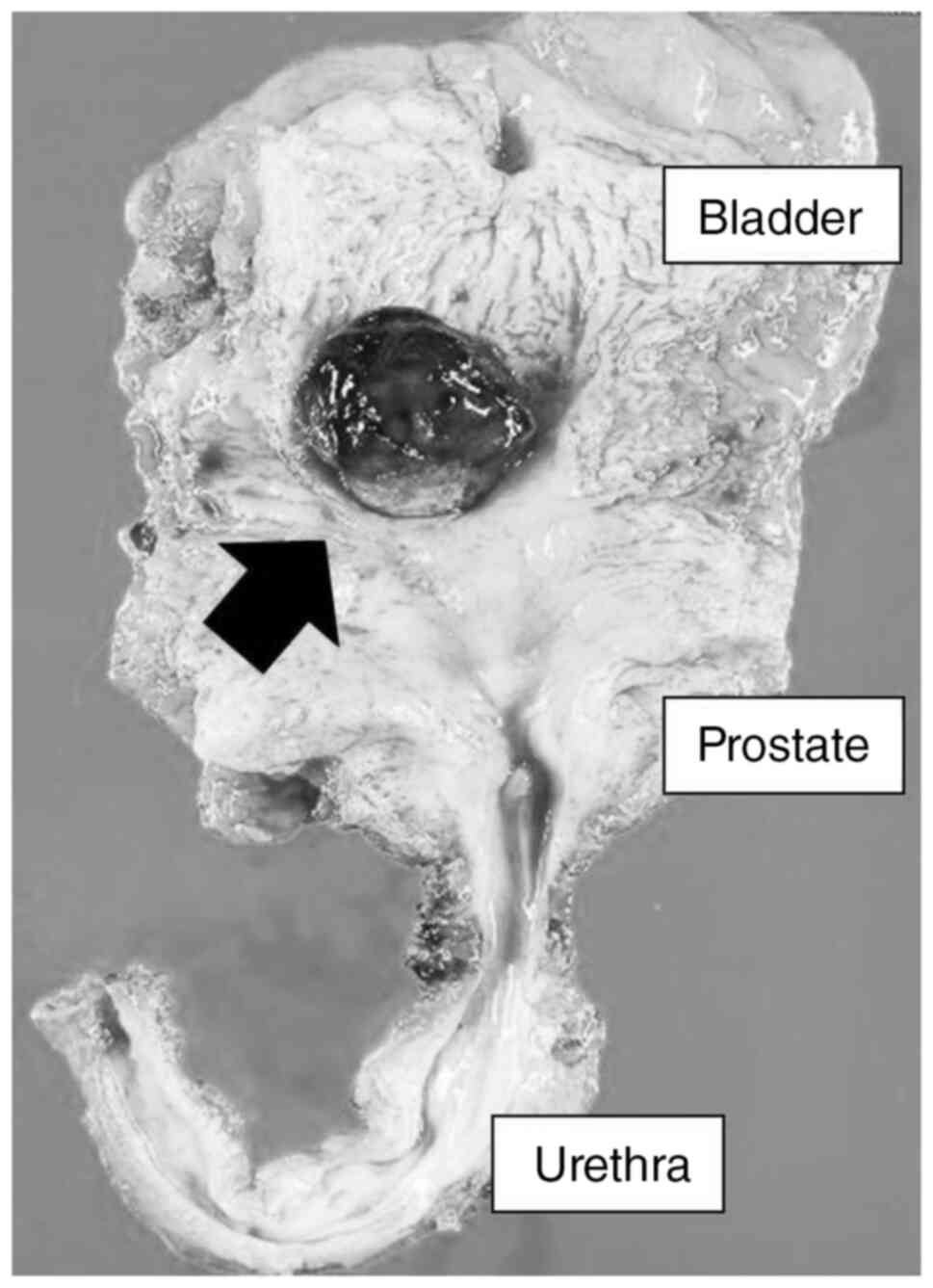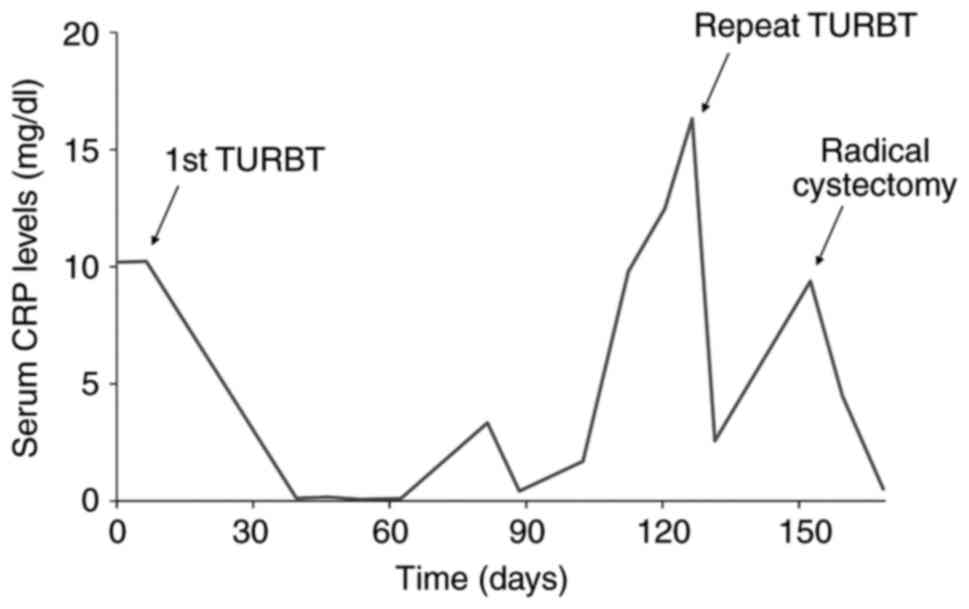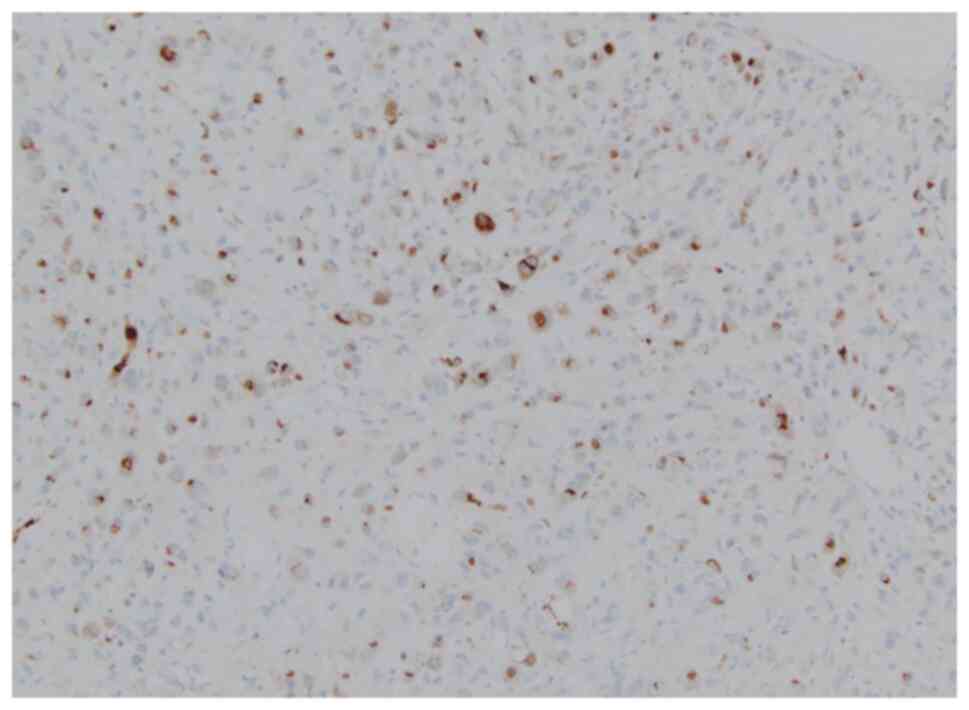Genomic analysis of bladder urothelial carcinoma with osteoclast‑like giant cells: A case report
- Authors:
- Published online on: June 20, 2024 https://doi.org/10.3892/mco.2024.2753
- Article Number: 55
-
Copyright: © Kameyama et al. This is an open access article distributed under the terms of Creative Commons Attribution License.
Abstract
Introduction
Although an osteoclast-like giant cell (OGC) tumor of bone is capable of malignancy, its typical feature is that of a benign tumor (1). OGC tumors in other organs, by contrast, are malignant neoplasms. OGC tumors have been found in several other organs including liver, breast, gallbladder, and pancreas (2-6). Among various histological subtypes of urothelial carcinoma (UC), carcinoma with OGC resembling a giant cell tumor of bone is extremely rare and only a few reports of urothelial carcinoma of the bladder with osteoclast-like giant cells (UCOGCs) have been reported (7-11). The fifth edition of the WHO Urinary and Male Genital Tumours classified UCOGCs as a poorly differentiated UC (12). The standard of care for and the prediction of the prognosis of UCOGCs remain unclear due to limited number of patients. To date, only one case report of UCOGCs with genetic testing has been reported. As the clinical utility of cancer gene panel testing in diagnosis and therapeutic decision-making is widely recognized, further accumulation of genomic results of UCOGCs is needed. Therefore, we performed genomic analysis of invasive UC with OGCs using a cancer panel test.
Case report
A 75-year-old man presented to Central Japan International Medical Center in November 2022 with gross hematuria and pain on voiding. Cystoscopy, computed tomography (CT), and magnetic resonance imaging (MRI) revealed a bladder tumor of 56 mm in diameter on the right wall of the bladder (Fig. 1A,B). Serum C-reactive protein (CRP) level was 10.19 mg/l. As no muscle invasion or metastasis was suspected, transurethral resection of the bladder tumor (TURBT) was performed (resected tumor weight: 54 g). Hematoxylin and eosin staining revealed that the tumor cells showed significant atypia and were accompanied by multinucleated cells positive for CD68 (Ventana Medical Systems, AZ, USA, 518-102425) (Fig. 2A,B). Immunohistochemistry also showed the tumor cells to be positive for AE1/AE3 (Ventana Medical Systems, 518-110178), partly positive for GATA3 (Ventana Medical Systems, 518-111953), and strongly positive for Ki-67 (Ventana Medical Systems, 518-102456) (Fig. 2C,D,E) but negative for CK7 (Ventana Medical Systems, 518-100902), CK20 (Ventana Medical Systems, 518-101152), CK5/6 (Ventana Medical Systems, 518-109851), and p63 (Ventana Medical Systems, 518-10961). Eventually, the tumor was pathologically diagnosed as UCOGCs with muscle invasion. As no standard of care for UCOGCs has been established, neoadjuvant chemotherapy using gemcitabine and cisplatin was started prior to radical cystectomy similar to treatment for usual muscle invasive cancer. A CT scan showed a large recurrent tumor in the bladder after the second course of chemotherapy (Fig. 1C), so radical cystectomy was planned rather than additional chemotherapy. During the surgical waiting time, at four months after the first TURBT, the patient suffered from pronounced bladder tamponade due to bleeding from the tumor, and he underwent unplanned repeat TURBT (resected tumor volume: 30 g). MRI just after surgery showed no residual tumor (Fig. 1D). One month later, robot-assisted radical cystectomy with lymph node dissection and ileal conduit reconstruction were performed. Macroscopically, a large recurrent tumor of 30 mm in diameter was observed again (Fig. 3), and pathological findings were invasive UC with OGCs, high grade, pT3b, pN1 (right internal iliac lymph node), RM0. Serum CRP levels were high when a high-volume tumor was present in the patient (Fig. 4). Additional immunohistochemistry showed tumor cells were positive for IL-6 (GeneTex, CA, USA, GTX110527) and OGCs were partly positive (Fig. 5).
Next, we analyzed the genomic features using a cancer panel test. The area containing predominantly tumor cells and OGCs was selected by a pathologist, and then the specimen was macro-dissected from formalin-fixed paraffin-embedded (FFPE) tissue sections. DNA isolation and sequencing following genome annotation and curation were performed as previously reported (13). Briefly, DNA was extracted using a Maxwell RSC DNA FFPE Kit-PKK, Custom (Promega, Fitchburg, WI, USA). DNA libraries were prepared for subsequent genomic sequencing following gene amplification using the GeneRead Human Comprehensive Cancer Panel (160 genes, NGHS-501X; Qiagen). Targeted amplicon exome sequencing for cancer-related genes was performed using the Illumina Miseq sequencing platform (Illumina, San Diego, CA, USA). Genome annotation and curation were performed using GenomeJack software (Mitsubishi Electric Software Corporation, Tokyo, Japan) (14). The genes detected with genetic alterations were as follows: TERT promoter (-124C>T; ClinVar pathogenic), PIK3CA (E542K; ClinVar pathogenic), HRAS (G13R; ClinVar pathogenic), ARAF (5 times the copy number amplification), CDKN2A (copy number loss), TP53 (E285V; ClinVar pathogenic), and ARID1A (truncate mutation). Tumor mutation burden was 5.9 Mut/Mbp, and microsatellite instability status was stable.
Discussion
Various pathological subtypes of UC are known. Among them, UCOGCs is included in the subtype of poorly differentiated UC (12). Its clinical symptoms are similar to those of conventional UC (e.g., gross hematuria) (7-11) and our patient presented with hematuria and pain on voiding. The clinical characteristics of the rare subtypes of UC are poorly understood, and no standard or optimal treatment has been established due to the limited number of cases (15). In previous reports, surgical treatment of either TURBT or radical cystectomy was performed for invasive UC with OGC of the bladder (7-11). In those cases, both no recurrence of cancer and an aggressive clinical course with patient deaths were reported. Several subtypes of UC have been reported as predictive factors for worse clinical outcomes (16,17). Our patient showed no recurrence during the 10 months after the surgery without adjuvant chemotherapy, but the postoperative follow-up period was too short to evaluate recurrence adequately.
UCOGCs is usually composed of mononuclear carcinoma cells, host histiocytes, and multinucleated OGCs. A conventional component of UC often coexists with UCOGCs (12). As shown in our result, OGCs show no nuclear pleomorphism of the nuclei, and they are positive for CD68 histiocytic markers (12,18).
There are many reports on the relationship between serum CRP levels and various cancers including bladder cancer (19,20). The preoperative CRP levels were reported to be a predictive factor for primary tumor stage, lymph node metastasis, and cancer-specific and overall survival in muscle invasive bladder cancer (20). In the present case, CRP levels were high when tumor volumes were high. We previously reported that prostate cancer cell lines secrete IL-6 and IL-8 and that those chemokines promote CD11b-positive cells to differentiate into osteoclast like multinuclear cells (21). We infer that IL-6 secreted from tumor cells may promote OGC formation and increase CRP levels in our case.
As UCOGCs is a very rare subtype of UC, few genomic studies have been reported. To the best of our knowledge, only a single case of genomic testing for UCOGCs has been reported, and it showed a TP53 mutation (11). UC had a higher rate of genomic alteration compared to that of other urologic cancers (13). In the present case, we found pathogenic variants in five genes including TP53 and copy number alterations in two genes. These genomic alterations were similar to those in conventional urothelial carcinomas (22-26). To explain the difference in clinical course between UCOGCs and conventional UC, further research including whole genome sequencing will be needed.
There are several reports on genomic analysis of OGCs other than UC. Mutations in KRAS, BRCA2, CDKN2A, TP53, SMAD4, and GNAS in undifferentiated carcinoma with OGCs of the pancreas are reported (27-29). A mutation in TP53 was identified in uterine leiomyosarcoma with OGCs (30). It was also reported that genetic testing has been linked to treatment for undifferentiated carcinoma with OGCs of the pancreas. Although pancreatic cancers generally exhibit a suboptimal response to immune checkpoint inhibitors, pembrolizumab as a third-line therapy is more effective for pancreatic cancers of undifferentiated carcinoma with OGCs showing a high tumor mutation burden (31). Platinum-based chemotherapy is standard treatment for advanced bladder cancer (32-34). Mutations in ARID1A, TP53, and MDM2 were reported as negative predictive factors for platinum-based chemotherapy (35-38). In our case, it is possible that some genetic mutation is responsible for platinum-based drug resistance. Therefore, targeted therapy based on the result of genomic test could be considered in next treatment.
In conclusion, we showed genomic alteration in a patient with UCOGCs. Genetic alterations or IL-6 production may be associated with increased inflammatory response and OGC formation, as well as resistance to cisplatin-based chemotherapy. These results may contribute to further research on UCOGCs to find precise treatments for this rare disease.
Acknowledgements
Not applicable.
Funding
Funding: This work was supported by Gifu Prefecture Medical Association Research Grant.
Availability of data and materials
The data generated in the present study may be requested from the corresponding author.
Authors' contributions
KK and KMi conceived the study. KK, KMi, TY, SS, KMa, KH, YK, HN, SI and TD contributed to data analysis and interpretation. KK, KMi, SK and SY performed clinical evaluations and treatment. KK and KMi wrote and edited the manuscript. KK and KMi confirm the authenticity of all the raw data. All authors read and approved the final manuscript.
Ethics approval and consent participate
This study was approved by the research ethics committee of Central Japan International Medical Center (approval no. 2022-013). Written informed consent was obtained from the patient for this study.
Patient consent for publication
Written informed consent was obtained from the patient for the publication of the case report and any accompanying images.
Competing interests
The authors declare that they have no competing interests.
References
|
Palmerini E, Picci P, Reichardt P and Downey G: Malignancy in giant cell tumor of bone: A review of the literature. Technol Cancer Res Treat. 18(1533033819840000)2019.PubMed/NCBI View Article : Google Scholar | |
|
Geramizadeh B and Kazemi K: Osteoclastoma-like giant cell tumor of the liver, an extremely rare tumor. Hepatitis Monthly. 17(e56097)2017. | |
|
Angellotti G, Tomasicchio G, Montanaro AE, Telgrafo M, Mastropasqua MG and Punzo C: Osteoclast-like stromal giant cells in invasive ductal breast cancer: A case series. Int J Surg Case Rep. 97(107421)2022.PubMed/NCBI View Article : Google Scholar | |
|
Wang YJ, Huang CP, Hong ZJ, Liao GS and Yu JC: Invasive breast carcinoma with osteoclast-like stromal giant cells: A case report. World J Clin Cases. 11:1521–1527. 2023.PubMed/NCBI View Article : Google Scholar | |
|
Niwa A, Tomita H, Watanabe N, Kiriyama S, Hara A and Tanaka T: Case report: A case of gallbladder carcinosarcoma with osteoclast-like multinucleated giant cells that was associated with RANK-RANKL signaling. Pathol Oncol Res. 28(1610134)2022.PubMed/NCBI View Article : Google Scholar | |
|
Zhao N, Mei Y, Yi H, Wang H, Wang Y, Yao Y and Li C: Case report: Pathological and genetic features of pancreatic undifferentiated carcinoma with osteoclast-like giant cells. Pathol Oncol Res. 29(1610983)2023.PubMed/NCBI View Article : Google Scholar | |
|
Baydar D, Amin MB and Epstein JI: Osteoclast-rich undifferentiated carcinomas of the urinary tract. Mod Pathol. 19:161–171. 2006.PubMed/NCBI View Article : Google Scholar | |
|
Wu PJ, Su CK, Li JR, Yang CR and Chen CL: Osteoclast-like giant cell carcinoma of the urinary bladder. J Chin Med Assoc. 72:495–497. 2009.PubMed/NCBI View Article : Google Scholar | |
|
Osman C, Muammer B, Murat O, Tamer A and Fatih A: Osteoclast-type giant cell carcinoma of the urinary bladder: An unusual and aggressive variant of urothelial carcinoma. Urol Case Rep. 23:50–51. 2019.PubMed/NCBI View Article : Google Scholar | |
|
Karasavvidou F, Mitrakas L, Strataki M, Anastasiou D, Koukoulis G and Tzortzis V: Poorly differentiated muscle-invasive giant cell tumor of the bladder leads to unfavorable clinical outcome. J Surg Case Rep. 2022(rjac046)2022.PubMed/NCBI View Article : Google Scholar | |
|
Satturwar S, Parwani AV, Thomas R, Bastacky S, Dhir R and Quiroga-Garza GM: The osteoclast-type giant cell rich carcinoma of urinary bladder: A case series. Pathol Res Pract. 239(154164)2022.PubMed/NCBI View Article : Google Scholar | |
|
WHO Classification of Tumours Editorial Board: Urinary and male genital tumours 5th edition. International Agency for Research on Cancer, Lyon, France, 2022. | |
|
Mizutani K, Hirade K, Sugiyama S, Kato Y, Nishihara H and Ishihara S: Genomic landscape of treatment-naive urological cancers using next-generation sequencing-based panel test in the Japanese population. Int J Urol. 29:909–911. 2022.PubMed/NCBI View Article : Google Scholar | |
|
Shimozaki K, Hayashi H, Tanishima S, Horie S, Chida A, Tsugaru K, Togasaki K, Kawasaki K, Aimono E, Hirata K, et al: Concordance analysis of microsatellite instability status between polymerase chain reaction based testing and next generation sequencing for solid tumors. Sci Rep. 11(20003)2021.PubMed/NCBI View Article : Google Scholar | |
|
Warrick JI: Clinical significance of histologic variants of bladder cancer. J Natl Compr Canc Netw. 15:1268–1274. 2017.PubMed/NCBI View Article : Google Scholar | |
|
Monn MF, Kaimakliotis HZ, Pedrosa JA, Cary KC, Bihrle R, Cheng L and Koch MO: Contemporary bladder cancer: Variant histology may be a significant driver of disease. Urol Oncol. 33:18.e15–18.e20. 2015.PubMed/NCBI View Article : Google Scholar | |
|
Mori K, Abufaraj M, Mostafaei H, Quhal F, Karakiewicz PI, Briganti A, Kimura S, Egawa S and Shariat SF: A systematic review and meta-analysis of variant histology in urothelial carcinoma of the bladder treated with radical cystectomy. J Urol. 204:1129–1140. 2020.PubMed/NCBI View Article : Google Scholar | |
|
Eble JN, Argani P, Grignon DJ and Cheng L: American Registry of Pathology: Tumors of the kidney, bladder, and related urinary structures. American Registry of Pathology Arlington, Virginia, Arlington, Virginia, 2022. | |
|
Allin KH, Bojesen SE and Nordestgaard BG: Baseline C-reactive protein is associated with incident cancer and survival in patients with cancer. J Clin Oncol. 27:2217–2224. 2009.PubMed/NCBI View Article : Google Scholar | |
|
O'Brian D, Prunty M, Hill A and Shoag J: The role of C-reactive protein in kidney, bladder, and prostate cancers. Front Immunol. 12(721989)2021.PubMed/NCBI View Article : Google Scholar | |
|
Mizutani K, Sud S and Pienta KJ: Prostate cancer promotes CD11b positive cells to differentiate into osteoclasts. J Cell Biochem. 106:563–569. 2009.PubMed/NCBI View Article : Google Scholar | |
|
Nassar AH, Umeton R, Kim J, Lundgren K, Harshman L, Van Allen EM, Preston M, Dong F, Bellmunt J, Mouw KW, et al: Mutational analysis of 472 urothelial carcinoma across grades and anatomic sites. Clin Cancer Res. 25:2458–2470. 2019.PubMed/NCBI View Article : Google Scholar | |
|
Robertson AG, Kim J, Al-Ahmadie H, Bellmunt J, Guo G, Cherniack AD, Hinoue T, Laird PW, Hoadley KA, Akbani R, et al: Comprehensive molecular characterization of muscle-invasive bladder cancer. Cell. 171:540–556 e525. 2017.PubMed/NCBI View Article : Google Scholar | |
|
Pietzak EJ, Bagrodia A, Cha EK, Drill EN, Iyer G, Isharwal S, Ostrovnaya I, Baez P, Li Q, Berger MF, et al: Next-generation sequencing of nonmuscle invasive bladder cancer reveals potential biomarkers and rational therapeutic targets. Eur Urol. 72:952–959. 2017.PubMed/NCBI View Article : Google Scholar | |
|
Springer SU, Chen CH, Pena MDC, Li L, Douville C, Wang Y, Cohen JD, Taheri D, Silliman N, Schaefer J, et al: Non-invasive detection of urothelial cancer through the analysis of driver gene mutations and aneuploidy. Elife. 7(e32143)2018.PubMed/NCBI View Article : Google Scholar | |
|
Shuai H, Duan X, Zhou JJ, Liu Y and Wu T: Effect of the TERT mutation on the prognosis of patients with urothelial carcinoma: A systematic review and meta-analysis. BMC Urol. 23(177)2023.PubMed/NCBI View Article : Google Scholar | |
|
Yang G, Yin J, Ou K, Du Q, Ren W, Jin Y, Peng L and Yang L: Undifferentiated carcinoma with osteoclast-like giant cells of the pancreas harboring KRAS and BRCA mutations: Case report and whole exome sequencing analysis. BMC Gastroenterol. 20(202)2020.PubMed/NCBI View Article : Google Scholar | |
|
Luchini C, Pea A, Lionheart G, Mafficini A, Nottegar A, Veronese N, Chianchiano P, Brosens LA, Noë M, Offerhaus GJA, et al: Pancreatic undifferentiated carcinoma with osteoclast-like giant cells is genetically similar to, but clinically distinct from, conventional ductal adenocarcinoma. J Pathol. 243:148–154. 2017.PubMed/NCBI View Article : Google Scholar | |
|
Yamamoto S and Sakai Y: A case of undifferentiated carcinoma with osteoclast-like giant cells of the pancreas derived from an intraductal papillary mucinous neoplasm. Clin J Gastroenterol. 14:1263–1268. 2021.PubMed/NCBI View Article : Google Scholar | |
|
Chen Z, Ji J, Yung E, Martin SE and Walia S: Uterine leiomyosarcoma with osteoclast-like giant cells: Report of 2 cases and review of literature. Int J Gynecol Pathol. 43:182–189. 2023.PubMed/NCBI View Article : Google Scholar | |
|
Besaw RJ, Terra AR, Malvar GL, Chapman TR, Hertan LM and Schlechter BL: Durable response to PD-1 blockade in a patient with metastatic pancreatic undifferentiated carcinoma with osteoclast-like giant cells. J Natl Compr Canc Netw. 19:247–252. 2021.PubMed/NCBI View Article : Google Scholar | |
|
Flaig TW, Spiess PE, Abern M, Agarwal N, Bangs R, Boorjian SA, Buyyounouski MK, Chan K, Chang S, Friedlander T, et al: NCCN Guidelines® insights: Bladder cancer, version 2.2022. J Natl Compr Canc Netw. 20:866–878. 2022.PubMed/NCBI View Article : Google Scholar | |
|
Cathomas R, Lorch A, Bruins HM, Comperat EM, Cowan NC, Efstathiou JA, Fietkau R, Gakis G, Hernandez V, Espinos EL, et al: The 2021 updated European association of urology guidelines on metastatic urothelial carcinoma. Eur Urol. 81:95–103. 2022.PubMed/NCBI View Article : Google Scholar | |
|
Grossman HB, Natale RB, Tangen CM, Speights VO, Vogelzang NJ, Trump DL, deVere White RW, Sarosdy MF, Wood DP Jr, Raghavan D, et al: Neoadjuvant chemotherapy plus cystectomy compared with cystectomy alone for locally advanced bladder cancer. N Engl J Med. 349:859–866. 2003.PubMed/NCBI View Article : Google Scholar | |
|
Plimack ER, Dunbrack RL, Brennan TA, Andrake MD, Zhou Y, Serebriiskii IG, Slifker M, Alpaugh K, Dulaimi E, Palma N, et al: Defects in DNA repair genes predict response to neoadjuvant cisplatin-based chemotherapy in muscle-invasive bladder cancer. Eur Urol. 68:959–967. 2015.PubMed/NCBI View Article : Google Scholar | |
|
Teo MY, Bambury RM, Zabor EC, Jordan E, Al-Ahmadie H, Boyd ME, Bouvier N, Mullane SA, Cha EK, Roper N, et al: DNA damage response and repair gene alterations are associated with improved survival in patients with platinum-treated advanced urothelial carcinoma. Clin Cancer Res. 23:3610–3618. 2017.PubMed/NCBI View Article : Google Scholar | |
|
Lee SH, Cheon J, Lee S, Kang B, Kim C, Shim HS, Park YN, Jung S, Choi SH, Choi HJ, et al: ARID1A mutation from targeted next-generation sequencing predicts primary resistance to gemcitabine and cisplatin chemotherapy in advanced biliary tract cancer. Cancer Res Treat. 55:1291–1302. 2023.PubMed/NCBI View Article : Google Scholar | |
|
Bagrodia A, Lee BH, Lee W, Cha EK, Sfakianos JP, Iyer G, Pietzak EJ, Gao SP, Zabor EC, Ostrovnaya I, et al: Genetic determinants of cisplatin resistance in patients with advanced germ cell tumors. J Clin Oncol. 34:4000–4007. 2016.PubMed/NCBI View Article : Google Scholar |



